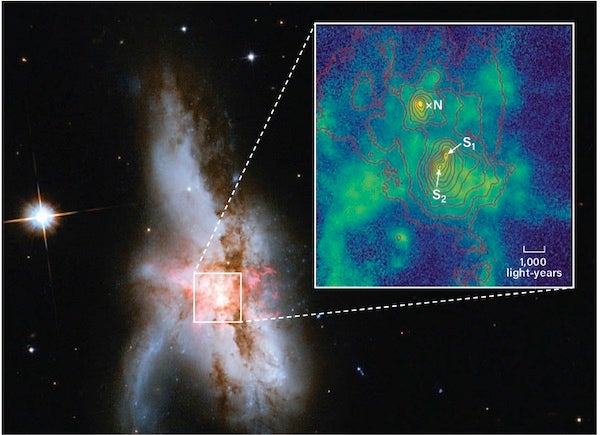A: When two supermassive black holes finally merge, their million-year-long orbital dance culminates with an incredible burst of gravitational waves. If this takes place in the core of a galaxy, it can have dramatic effects on the environment. The gravitational radiation can deposit energy into the surrounding gas, heating it up and making it glow in infrared light for tens of thousands of years. Furthermore, the new supermassive black hole born from the merger will generally recoil from the crash, perturbing the orbits of nearby gas and stars. For a sufficiently strong recoil, the new black hole may even be ejected from the galactic core altogether, further affecting future dynamics within the galaxy. Although several of these processes can lead to X-rays and other high-energy electromagnetic emission, they would likely not destroy the galaxy.
NGC 6240 appears to have three supermassive black holes. Generally, three-body orbits are not gravitationally stable: Either two of the objects will merge first, or one of them (generally the lightest) will be ejected from the triad. This means that all three black holes won’t merge at once.
However, the gravitational forces of a third body can have lasting effects on a supermassive black hole pair. For example, the pair’s orbit can become highly eccentric, which speeds up the merger through enhanced emission of gravitational waves. In fact, the presence of a third supermassive black hole is believed to play a crucial role in making supermassive black hole mergers possible at all. In the next decade, we will learn more about this and related questions thanks to gravitational-wave observations from pulsar timing arrays and the upcoming Laser Interferometer Space Antenna mission.
The observational indications for a third supermassive black hole in NGC 6240 are very recent — the find was published January 14 of this year. What will happen in this system — whether one black hole will be kicked out or whether two will merge first, with the third following — will take time for astronomers to untangle.
There is no rush, however, since the black holes in NGC 6240 will not merge for at least another 10 million years!










